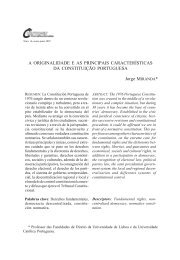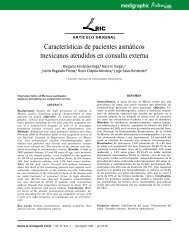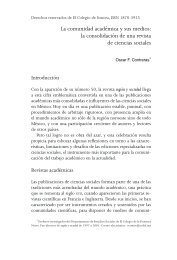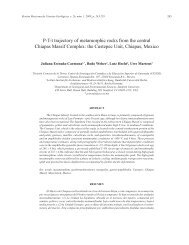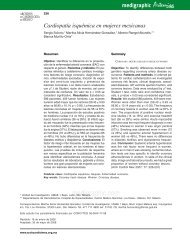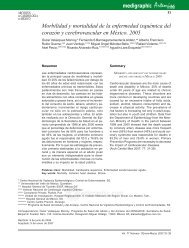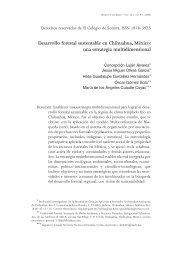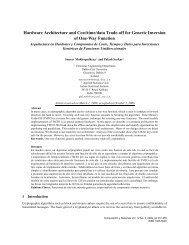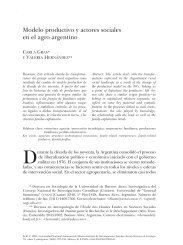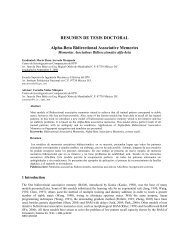Synopsis of Cenozoic decapod crustaceans from Belgium - SciELO
Synopsis of Cenozoic decapod crustaceans from Belgium - SciELO
Synopsis of Cenozoic decapod crustaceans from Belgium - SciELO
Create successful ePaper yourself
Turn your PDF publications into a flip-book with our unique Google optimized e-Paper software.
370<br />
van Revista Bakel Mexicana et al. de Ciencias Geológicas, v. 23, núm. 3, 2006, p. 370-374<br />
<strong>Synopsis</strong> <strong>of</strong> <strong>Cenozoic</strong> <strong>decapod</strong> <strong>crustaceans</strong><br />
<strong>from</strong> <strong>Belgium</strong><br />
Barry W. M. van Bakel 1,* , René H. B. Fraaije 1 , and John W. M. Jagt 2<br />
1<br />
Oertijdmuseum De Groene Poort, Bosscheweg 80, NL-5283 WB Boxtel, The Netherlands.<br />
2<br />
Natuurhistorisch Museum Maastricht, de Bosquetplein 6-7, NL-6211 KJ Maastricht, The Netherlands.<br />
* barry.van.bakel@wolmail.nl<br />
ABSTRACT<br />
Decapod <strong>crustaceans</strong> are fairly common in <strong>Cenozoic</strong> strata <strong>of</strong> northwestern and southern <strong>Belgium</strong>.<br />
In this work, the stratigraphic distribution <strong>of</strong> all known species is summarized.<br />
Key words: Crustacea, Decapoda, <strong>Cenozoic</strong>, <strong>Belgium</strong>.<br />
RESUMEN<br />
Los crustáceos decápodos son comunes en estratos cenozoicos del noroeste y sur de Bélgica. En<br />
este trabajo se resume la distribución estratigráfi ca de todas las especies conocidas.<br />
Palabras clave: Crustacea, Decapoda, <strong>Cenozoic</strong>o, Bélgica.<br />
INTRODUCTION<br />
Van Straelen (1921) provided a list <strong>of</strong> all <strong>decapod</strong><br />
<strong>crustaceans</strong> then known <strong>from</strong> <strong>Cenozoic</strong> deposits <strong>of</strong> <strong>Belgium</strong><br />
(Table 1). His collection <strong>of</strong> fossil Crustacea is stored at<br />
the Institut Royal des Sciences Naturelles de Belgique<br />
(IRScNB, Brussels), but needs to be reviewed (Feldmann<br />
and Dhondt, 1991).<br />
The purpose <strong>of</strong> this contribution is to provide an<br />
updated list <strong>of</strong> all Paleogene and Neogene <strong>decapod</strong> <strong>crustaceans</strong><br />
<strong>from</strong> <strong>Belgium</strong> known to date. Thirty-five species, in<br />
thirty-one genera are currently recorded. These <strong>decapod</strong>s<br />
comprise one palinuroid, one nephropid, seven thalassinoids<br />
and twenty-six brachyurans (Table 2).<br />
SUMMARY OF MATERIAL<br />
Eocene<br />
Eocene strata are widely distributed in central and<br />
southern <strong>Belgium</strong>. Collins and Smith (1993) described<br />
the new calappid Silvacarcinus laurae associated with<br />
the raninid Raninoides glabra (Woodward, 1871) <strong>from</strong><br />
the Ypresian at Forest (Brussels). A second assemblage <strong>of</strong><br />
Ypresian age is known <strong>from</strong> Marke near Kortrijk (southern<br />
<strong>Belgium</strong>). Zanthopsis cf. leachii (Desmarest, 1822)<br />
is common at this locality, with rarer occurrences <strong>of</strong> the<br />
spear lobster Linuparus scyllariformis (Bell, 1857). The<br />
most diverse Ypresian assemblage is known <strong>from</strong> clays at
<strong>Cenozoic</strong> <strong>decapod</strong>s <strong>from</strong> <strong>Belgium</strong> 371<br />
Table 1. Van Straelen’s (1921) list <strong>of</strong> <strong>Cenozoic</strong> <strong>decapod</strong> <strong>crustaceans</strong> <strong>from</strong> <strong>Belgium</strong>.<br />
Species (current status) Verified Endemic Stratigraphic occurrence<br />
Linuparus scyllariformis (Bell, 1857) Y Ypresian, ‘Bruxellian’<br />
Hoploparia gammaroides M’Coy, 1849<br />
Ypresian<br />
H. corneti van Straelen, 1920 Y Ypresian<br />
Zanthopsis leachii (Desmarest, 1822) Y Ypresian, ’Bruxellian’<br />
Z. bispinosa M’Coy, 1849 Ypresian, ‘Bruxellian’<br />
Z. unispinosa M’Coy, 1849 Ypresian, ‘Bruxellian’<br />
Portunites incerta Bell, 1858<br />
Ypresian<br />
Glyphithyreus wetherelli (Bell, 1858) Y Ypresian, ‘Bruxellian’<br />
Xanthilites bowerbanki Bell, 1858<br />
Ypresian<br />
Callianassa sp.<br />
‘Bruxellian’<br />
Calappa sp.<br />
‘Bruxellian’<br />
Palaeocarpilius sp.<br />
‘Bruxellian’<br />
Etisus sp.<br />
‘Bruxellian’<br />
Cancer burtini Galeotti, 1837 Y ‘Bruxellian’<br />
Goniochele angulata Bell, 1858 Y ‘Bruxellian’<br />
Egem, including L. scyllariformis, Glyphithyreus wetherelli<br />
(Bell, 1858) (Figure 1.4), and undescribed species <strong>of</strong><br />
Upogebia and Retropluma. In addition, a single carapace <strong>of</strong><br />
Goniochele, possibly G. angulata Bell, 1858 has recently<br />
been discovered.<br />
Possibly new species <strong>of</strong> Pagurus and Stevea are<br />
found in Middle Eocene (Ledian) deposits near Balegem,<br />
while Lutetian strata temporarily accessible at Zaventem<br />
airport (Brussels) have yielded several specimens <strong>of</strong><br />
Harpactocarcinus punctulatus (Desmarest, 1822).<br />
Table 2. Updated list <strong>of</strong> <strong>Cenozoic</strong> <strong>decapod</strong> <strong>crustaceans</strong> <strong>from</strong> <strong>Belgium</strong> (as <strong>of</strong> September 2005).<br />
EOCENE Zanthopsis cf. leachii (Desmarest, 1822) Collins and Smith (1993) Marke (Kortrijk)<br />
Harpactocarcinus punctulatus (Desmarest, 1822) herein Zaventem (Brussels)<br />
Raninoides glabra (Woodward, 1871) Collins and Smith (1993) Forest (Brussels)<br />
Silvacarcinus laurae Collins and Smith, 1993 Collins and Smith (1993) Forest (Brussels)<br />
Glyphithyreus wetherelli (Bell, 1858) herein Egem<br />
Linuparus scyllariformis (Bell, 1857) herein Egem, Marke (Kortrijk)<br />
Upogebia n. sp. herein Egem<br />
Stevea n. sp. herein Balegem<br />
Retropluma n. sp. herein Egem<br />
Goniochele cf. angulata Bell, 1858 van Straelen (1921) Egem<br />
Pagurus n. sp. herein Balegem<br />
OLIGOCENE Ciliopagurus obesus van Bakel et al., 2003 van Bakel et al. (2003b) Sint-Niklaas<br />
Coeloma (Coeloma) sp. herein Sint-Niklaas<br />
Coeloma (Paracoeloma) rupeliense Stainier, 1887 Stainier (1887) Boom<br />
Eocarpilius wilkeningi (Bachmayer and Mundlos, 1968) herein Zemst<br />
Homarus percyi van Beneden, 1872 van Beneden (1872) Boom<br />
dromiid n. gen, n. sp. herein Sint-Niklaas<br />
MIOCENE Tasadia carniolica (Bittner, 1884) Janssen and Müller (1884) Ramsel, Berlaar<br />
Mursia lienharti (Bachmayer, 1962) Janssen and Müller (1984) Ramsel<br />
Glebocarcinus n. sp. herein Borgerhout (Antwerpen)<br />
Calliax n. sp. herein Emblem<br />
PLIOCENE Callianassa sp. herein Kallo (Antwerpen)<br />
Galathea dispersa Bate, 1859 van Bakel et al. (2004) Kallo (Antwerpen)<br />
Pagurus bernhardus (von Linné, 1758) van Bakel et al. (2004) Kallo (Antwerpen)<br />
Ebalia cranchii Leach, 1817 van Bakel et al. (2004) Kallo (Antwerpen)<br />
Ebalia jacqueshermani van Bakel et al., 2004 van Bakel et al. (2004) Kallo (Antwerpen)<br />
Ebalia tumefacta (Montagu, 1808) van Bakel et al. (2004) Kallo (Antwerpen)<br />
Maja squinado (Herbst, 1788) van Bakel et al. (2004) Kallo (Antwerpen)<br />
Corystes holsaticus (Noetling, 1881) van Bakel et al. (2004) Kallo (Antwerpen)<br />
Cancer cf. pagurus Linné, 1758 van Bakel et al. (2004) Kallo (Antwerpen)<br />
Cancer vancalsteri van Bakel et al., 2003 van Bakel et al. (2003a) Oelegem<br />
Metacarcinus tenax van Bakel et al., 2004 van Bakel et al. (2004) Kallo (Antwerpen)<br />
Pliopirimela deconincki van Bakel et al., 2004 van Bakel et al. (2004) Kallo (Antwerpen)<br />
Liocarcinus holsatus (Fabricius, 1798) van Bakel et al. (2004) Kallo (Antwerpen)<br />
PLEISTOCENE Brachyura gen. et spec. indet. herein Kallo (Antwerpen)
372<br />
van Bakel et al.<br />
2 mm<br />
2)<br />
1)<br />
5 mm<br />
5 mm<br />
4)<br />
3)<br />
5 mm<br />
6)<br />
5)<br />
1 mm 10 mm<br />
Figure 1. <strong>Cenozoic</strong> <strong>decapod</strong> <strong>crustaceans</strong> <strong>from</strong> <strong>Belgium</strong>; abbreviation: MAB: collections <strong>of</strong> Oertijdmuseum De Groene Poort (Boxtel, the Netherlands).<br />
1: Ciliopagurus obesus van Bakel, Jagt and Fraaije, 2003b (MAB k.2365, holotype), Rupelian (Oligocene), Sint-Niklaas (SEM). 2: Axius sp. (MAB<br />
k.2404), lower Pliocene, Emblem; latex cast coated with ammonium chloride prior to photography. 3: Zanthopsis cf. leachii (Desmarest, 1822), juvenile<br />
(MAB k.2405), Ypresian (Lower Eocene), Marke (Kortrijk); specimen coated with ammonium chloride prior to photography. 4: Glyphithyreus wetherelli<br />
(Bell, 1858), dorsal carapace (MAB k.2406), Ypresian (Lower Eocene), Egem; specimen coated with ammonium chloride prior to photography. 5: Ebalia<br />
jacqueshermani van Bakel, Jagt, Fraaije and Wille, 2004 (MAB k.2372, holotype), Pliocene, Kallo (Antwerp) (SEM). 6: Metacarcinus tenax van Bakel,<br />
Jagt, Fraaije and Wille, 2004 (MAB k.2386, holotype), Pliocene, Kallo (Antwerp).
<strong>Cenozoic</strong> <strong>decapod</strong>s <strong>from</strong> <strong>Belgium</strong> 373<br />
<strong>Cenozoic</strong> <strong>decapod</strong> <strong>crustaceans</strong> listed by van Straelen<br />
in 1921 correspond chiefly to species <strong>of</strong> Eocene age. Of<br />
these, four have been verified on the basis <strong>of</strong> available<br />
material (Table 2). Of the remaining taxa, five were first<br />
described <strong>from</strong> outside <strong>Belgium</strong>. Occurrences <strong>of</strong> Zanthopsis<br />
have been lumped by us under the name <strong>of</strong> Zanthopsis<br />
cf. leachii (Figure 1.3). Van Straelen (1921) also listed Z.<br />
bispinosa M’Coy, 1849 and Z. unispinosa M’Coy, 1849,<br />
but we have not yet verified the validity <strong>of</strong> these species.<br />
Three other taxa, Hoploparia gammaroides M’Coy, 1849,<br />
Xanthilites bowerbanki Bell, 1858 and Portunites incerta<br />
Bell, 1858, are expected to occur at Egem.<br />
Unnamed species <strong>of</strong> Callianassa, Calappa, Palaeocarpilius<br />
and Etisus, all <strong>from</strong> ‘Bruxellian’ strata in the<br />
Brussels area, were noted by Le Hon (1862), while<br />
Hoploparia corneti van Straelen, 1920 and Cancer burtini<br />
Galeotti, 1837 definitely are <strong>from</strong> <strong>Belgium</strong> and may in fact<br />
be endemic, but the current whereabouts <strong>of</strong> the types (or<br />
additional material for that matter) is unknown to us.<br />
Oligocene<br />
Brachyuran faunas <strong>of</strong> Oligocene age are dominated<br />
by Coeloma (Paracoeloma) rupeliense Stainier, 1887.<br />
Numerous well-preserved specimens in concretions are<br />
known <strong>from</strong> the Boom area (Feldmann and Dhondt, 1991;<br />
Verheyden, 2002). Associated are much rarer remains <strong>of</strong> a<br />
large lobster, Homarus percyi van Beneden, 1872. Coeloma<br />
(P.) rupeliense has also been recorded <strong>from</strong> reworked<br />
nodules in post-Miocene transgressive deposits at Kallo<br />
(Antwerpen area). Claws <strong>of</strong> a new hermit crab, Ciliopagurus<br />
obesus, have been recently documented by van Bakel et al.<br />
(2003b) <strong>from</strong> Rupelian strata at Sint-Niklaas; these claws<br />
show a characteristic stridulatory apparatus (Figure 1.1).<br />
A single, small specimen <strong>of</strong> dromiid crab <strong>from</strong> the same<br />
locality and strata is currently under study; it appears to be<br />
close to Dromia eotvoesi Müller, 1976 <strong>from</strong> the Miocene<br />
<strong>of</strong> Hungary (Müller, 1984).<br />
Miocene<br />
As for Eocene and Oligocene assemblages, Miocene<br />
strata have also yielded a dominant crab fauna; numerous<br />
well-preserved specimens <strong>of</strong> Tasadia carniolica (Bittner,<br />
1884) have been collected, associated with much rarer<br />
material <strong>of</strong> Mursia lienharti (Bachmayer, 1962) (Janssen<br />
and Müller, 1984). In contrast to Eocene and Oligocene<br />
faunas, dominated by specimens <strong>of</strong> different sizes <strong>of</strong><br />
Zanthopsis and Coeloma respectively, the Miocene assemblage<br />
<strong>of</strong> Tasadia consists <strong>of</strong> remarkably equally sized<br />
individuals. Other growth stages and sizes appear to be<br />
missing, suggesting juveniles inhabited shallower water.<br />
The main locality to have furnished T. carniolica is now a<br />
rubbish tip. A few specimens <strong>of</strong> this species have recently<br />
been collected at Berlaar. A second, much larger cancroid<br />
represented by a single decorticated carapace was collected<br />
<strong>from</strong> Borgerhout (Antwerpen ring road). It most likely represents<br />
Glebocarcinus, characterised by distinctly swollen<br />
protogastric regions.<br />
Pliocene<br />
Van Bakel et al. (2000, 2004) described assemblages<br />
<strong>from</strong> Kallo (Antwerpen area), <strong>of</strong> Piacenzian age, comparable<br />
to extant faunas <strong>from</strong> the North Sea. Small-sized<br />
specimens were obtained by carefully emptying infill <strong>of</strong><br />
large gastropod shells (Figure 1.5). Larger specimens,<br />
such as the cancroids Cancer cf. pagurus Linnaeus, 1758,<br />
Metacarcinus tenax van Bakel et al., 2004 (Figure 1.6) and<br />
a well-preserved corpse <strong>of</strong> the spider crab Maja squinado<br />
(Herbst, 1788), were obtained by screening the wind-blown<br />
surfaces <strong>of</strong> foundation pits in dock works.<br />
A review <strong>of</strong> recently collected specimens <strong>of</strong> Corystes<br />
holsaticus (Noetling, 1881) has shown that Micromithrax<br />
Noetling, 1881 is a junior synonym <strong>of</strong> Corystes Latreille,<br />
1802. Recently, the new species Cancer vancalsteri has been<br />
described by van Bakel et al. (2003a) <strong>from</strong> Oelegem, dated<br />
as Pliocene on the associated molluscan faunule. A possibly<br />
new species <strong>of</strong> Axius <strong>from</strong> Emblem (east <strong>of</strong> Antwerpen) is<br />
under study (Figure 1.2).<br />
ACKNOWLEDGMENTS<br />
We thank L. Anthonis, F. van Calster, Y. Christiaens,<br />
L. De Coninck, J. Herman, A. Iserbyt, T. Lambrechts, R.<br />
Meuris, F. Mollen, E. Wille and F. Smet for their enthusiastic<br />
collecting and donation <strong>of</strong> material over the years.<br />
REFERENCES<br />
Bachmayer, F., 1962, Die Calappiden (Crustacea, Decapoda) aus den<br />
tortonischen Ablagerungen des Wiener Beckens: Annalen des<br />
naturhistorischen Museums in Wien, 65 [Festschrift Hans<br />
Strouhal], 39-46.<br />
Bachmayer, F., Mundlos, R., 1968, Die tertiären Krebse vom Helmstedt<br />
bei Braunschweig, Deutschland: Annalen des Naturhistorischen<br />
Museums in Wien, 72, 649-692.<br />
Bakel, B.W.M. van, Jagt, J.W.M., Fraaye, R.H.B., 2000, Pliocene <strong>decapod</strong><br />
<strong>crustaceans</strong> <strong>from</strong> Kallo (Northwest <strong>Belgium</strong>): Montecchio<br />
Maggiore, Associazione Amici del Museo Civico ‘G. Zannato’,<br />
Studi e Ricerche, 73-74.<br />
Bakel, B.W.M. van, Jagt, J.W.M., Fraaije, R.H.B., 2003a, A new Pliocene<br />
cancrid crab <strong>from</strong> Oelegem, province <strong>of</strong> Antwerpen (NW <strong>Belgium</strong>):<br />
Cainozoic Research, 2 (for 2002), 79-85.<br />
Bakel, B.W.M. van, Jagt, J.W.M., Fraaije, R.H.B., 2003b, Ciliopagurus<br />
obesus, a new species <strong>of</strong> Oligocene hermit crab <strong>from</strong> northwest<br />
<strong>Belgium</strong>: Cainozoic Research, 2 (for 2002), 109-116.<br />
Bakel, B.W.M. van, Jagt, J.W.M., Fraaije, R.H.B., Wille, E.R.H., 2004,<br />
Piacenzian (Pliocene) <strong>decapod</strong> crustacean faunules <strong>from</strong> northwest<br />
<strong>Belgium</strong>: Bulletin <strong>of</strong> the Mizunami Fossil Museum, 30 (for 2003),<br />
97-108.
374<br />
van Bakel et al.<br />
Bell, T., 1856-1858, A monograph <strong>of</strong> the fossil malacostracous Crustacea <strong>of</strong><br />
Great Britain. Part I. Crustacea <strong>of</strong> the London Clay: Monograph <strong>of</strong><br />
the Palaeontographical Society, London, 10(40), viii + 9-44.<br />
Beneden, P. van, 1872, Sur la découverte d’un homard fossile dans l’argile<br />
de Rupelmonde: Bulletin de l’Académie Royale de Belgique, 33,<br />
316-321.<br />
Bittner, A., 1884, Beiträge zur Kenntniss tertiärer Brachyuren-Faunen:<br />
Denkschrifte der mathematisch-naturwissenschaftliche Classe der<br />
kaiserlichen Akademie der Wissenschaften zu Wien, 48 (for 1883),<br />
444-449 [1-18].<br />
Collins, J. S. H., Smith, R., 1993, Ypresian (Lower Eocene) crabs (Decapoda,<br />
Crustacea) <strong>from</strong> <strong>Belgium</strong>: Bulletin de l’Institut Royal des Sciences<br />
Naturelles de Belgique, Sciences de la Terre, 63, 261-270.<br />
Desmarest, A.G., 1822, Les Crustacés proprement dits, in Brongniart,<br />
A., Desmarest, A.G. (eds.), Histoire naturelle des Crustacés<br />
fossiles, sous les rapports zoologiques et géologiques: Paris, F. G.<br />
Levrault, 138-425.<br />
Feldmann, R. M., Dhondt, A.V., 1991, The Van Straelen <strong>decapod</strong> collection,<br />
Institut royal des Sciences naturelles de Belgique, Bruxelles: Journal<br />
<strong>of</strong> Paleontology, 65, 514-515.<br />
Galeotti, H., 1837, Mémoire sur la constitution géognostique de la province<br />
de Brabant, en réponse à la question suivante: décrire la constitution<br />
géologique de la province de Brabant, déterminer avec soin les<br />
espèces minérales et les fossiles que les divers terrains renferment et<br />
indiquer la synonymie des auteurs qui en ont déjà traité: Mémoires<br />
Couronnés de l’Académie Royale des Sciences, des Lettres et des<br />
Beaux-Arts, 12, 1-192.<br />
Herbst, J.F.W., 1782-1790, Versuch einer Naturgeschichte der Krabben und<br />
Krebse, nebst systematischen Beschreibung ihrer verschiedenen<br />
Arten, 1.: Zürich, J.C. Fuessly, 1-274.<br />
Janssen, A.W., Müller, P., 1984, Miocene Decapoda and Mollusca <strong>from</strong><br />
Ramsel (province <strong>of</strong> Antwerpen, <strong>Belgium</strong>), with a new crab genus<br />
and a new cephalopod species: Scripta Geologica, 75, 1-26.<br />
Latreille, P.A., 1802-1803, Histoire naturelle, générale et particulière, des<br />
crustacés et des insectes, 3.: Paris, F. Dufart, xii + 467 pp.<br />
Leach, W. E., 1817, The Zoological Miscellany, being descriptions <strong>of</strong> new<br />
or interesting animals: London, 3, vi + 151 p.<br />
Le Hon, H., 1862, Terrains tertiaires de Bruxelles, leur composition,<br />
leur classement, leur faune et leur flore: Bulletin de la Société<br />
Géologique de France, (2)19, 804-821.<br />
Linnaeus, C. von, 1758, Systema naturae, per regna tria naturae, secundum<br />
classes, ordines, genera, species, cum characteribus, differentiis,<br />
synonymis, locis, 1(6), Regnum animale: Holmiae, Laurentii<br />
Salvii, iii + 824 pp.<br />
M’Coy, F., 1849, On the classification <strong>of</strong> some British fossil Crustacea,<br />
with notices <strong>of</strong> new forms in the University collection at<br />
Cambridge: Annals and Magazine <strong>of</strong> Natural History, Ser. 2,<br />
4(23), 330-335.<br />
Müller, P., 1976, Decapoda (Crustacea) fauna a budapesti miocénböl (4):<br />
Földtani Közlöny, 106, 149-160.<br />
Müller, P., 1984, Decapod Crustacea <strong>of</strong> the Badenian: Geologica Hungarica,<br />
Series Palaeontologica, 42, 1-317.<br />
Noetling, F., 1881, Ueber einige Brachyuren aus dem Senon von Mastricht<br />
[sic] und dem Tertiär Norddeutschlands: Zeitschrift der Deutschen<br />
Geologischen Gesellschaft, 33, 357-371.<br />
Stainier, X., 1887, Coeloma rupeliense brachyure nouveau de l’argile<br />
rupélienne: Annales de la Société Géologique de Belgique, 14,<br />
86-96.<br />
Straelen, V. van, 1920, Hoploparia corneti, crustacé décapode nouveau de<br />
l’Yprésien supérieur du Cuesmes: Bulletin de la Société Belge de<br />
Géologie, de Paléontologie et d’Hydrologie, 30, 136-138.<br />
Straelen, V. van, 1921, Catalogue des crustacés décapodes des terrains<br />
tertiaires de la Belgique: Annales de la Société Royale de Zoologie<br />
et de Malacologie de Belgique, 51, 111-131.<br />
Verheyden, T., 2002, Decapods <strong>from</strong> the Boom Clay (Rupelian, Oligocene)<br />
in <strong>Belgium</strong>: Bulletin de l’Institut Royal des Sciences Naturelles<br />
de Belgique, Sciences de la Terre, 72, 171-191.<br />
Woodward, H., 1871, Notes on some new <strong>crustaceans</strong> <strong>from</strong> the Lower<br />
Eocene <strong>of</strong> Portsmouth: Quarterly Journal <strong>of</strong> the Geological Society,<br />
London, 27, 90-92.<br />
Manuscript received: September 3, 2005<br />
Corrected manuscript received: January 14, 2006<br />
Manuscript accepted: February 23, 2006



